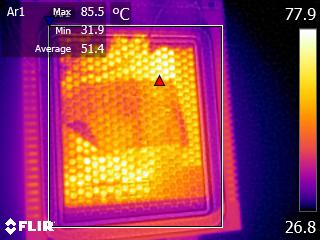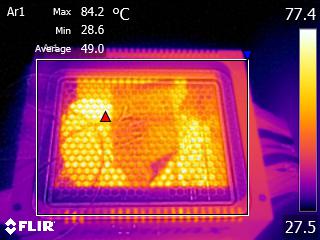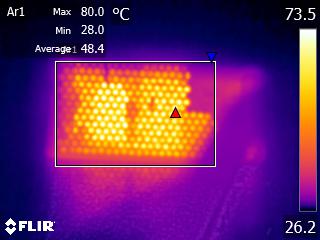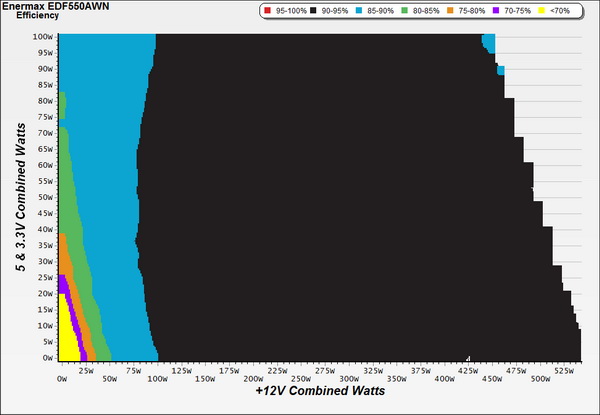Enermax Digifanless 550W Power Supply Review
Why you can trust Tom's Hardware
Cross-Load Tests And Infrared Images
To generate the following charts, we set our loaders to auto mode through our custom-made software before trying over a thousand possible load combinations with the +12V, 5V and 3.3V rails. The load regulation deviations in each of the charts below were calculated by taking the nominal values of the rails (12V, 5V and 3.3V) as point zero.
Our cross-load tests are described in detail here.
Load Regulation Charts
Load regulation on the +12V rail was really good, as you can see from the corresponding graph. The 5V rail registered tight load regulation as well, staying within two-percent deviation throughout the unit’s entire operational range. The 3.3V rail registered average performance for a high-end PSU; at almost half of the load combinations we tried in the cross-load tests, its deviation was within three percent.
Efficiency Chart
Overall, efficiency was high, remaining above 90 percent with higher than 90-100W loads.
Ripple Charts
The +12V ripple graph revealed that there were some spots with ripple in the 40–60mV range. This is nothing to worry about, though, since on the other load combinations, ripple suppression was good on all rails.
Infrared Images
At the end of the cross-load tests, we took some photos of the PSU as it was being tested with our modified FLIR E4 camera, which delivers 320x240 IR resolution (76,800 pixels).



The maximum temperature of the internals during the cross-load tests, which were performed at 28 to 30 degrees C ambient, reached 85.5 degrees C at the EMI filter's area.
Get Tom's Hardware's best news and in-depth reviews, straight to your inbox.
Current page: Cross-Load Tests And Infrared Images
Prev Page Efficiency, Temperatures And Noise Next Page Transient Response Tests
Aris Mpitziopoulos is a contributing editor at Tom's Hardware, covering PSUs.
-
blackmagnum If you think buying a mid-range PSU that costs as much as an enthusiast gaming CPU or graphics card, then you have more money than sense.Reply -
PaulBags Why'd my commented get deleted? "This is a passively-cooled PSU, so you should install it with the top exhaust grille facing downward." is totally wrong advice, if you don't believe me read the warnings in the picture YOU took.Reply -
Calculatron Ironically, I have yet to try an Enermax PSU, although I really like their other products; I have an ETS-T40-TB, a whole myriad of their fans, and the Ostrog Pink case.Reply -
uglyduckling81 "This is a passively-cooled PSU, so you should install it with the top exhaust grille facing downward. If you don’t follow this advice, hot air will be trapped inside the PSU"Reply
Hot air rises. If you have the opening facing down you will be trapping hot air inside. Read your own comment "top exhaust". 'Top' means on top, 'exhaust' means expulsion of air not intake.
The PSU clearly has vents on the back and sides so I think it's a moot point either way but it's clearly a better idea to install it with the top opening facing upwards. -
nukemaster Reply
I think your post got lost(forum bug maybe), not removed. I would see if it was removed and it was not.15875927 said:Why'd my commented get deleted? "This is a passively-cooled PSU, so you should install it with the top exhaust grille facing downward." is totally wrong advice, if you don't believe me read the warnings in the picture YOU took.
I think this would depend on the case you are using to be honest.
System air will cool it.
If the power supply is at the top of your system putting its vent up will cause heat to have no place to go in many cases. Power supplies in the bottom of the case would be better served with the power supply vent face up.
The power supply has software to let you see the temperatures anyway so you can test. Tom's tests in a hotbox so it is not an actual case.
http://www.tomshardware.com/reviews/how-we-test-psu,4042.html -
Aris_Mp guys sorry for this mistake. It is with the fan grill facing upwards and not down. This is how a single word can bring doom!Reply -
Blueberries These are solid! I'd take a SeaSonic SS-520FL2 for $140 over this any day, though!Reply -
PaulBags ReplyThese are solid! I'd take a SeaSonic SS-520FL2 for $140 over this any day, though!
I have the seasonic, I love it. I prefer the modular connector layout on it too, this emermax only offers a few oddly placed plugs by comparison. The cables arn't as good though, and you don't even get enough to populate all the plugs, although it's sufficent for most scenarios for a 520w PSU.
I'd very much like to see AC cable clips become standard, I've had the ac work loose on me before when I turned a case slightly to plug something in, glad I didn't have anything important up at the time.
To anyone who _would_ want the enermax over the seasonic I'm genuinely curious as to why. It's always good to learn and/or gain perspective. -
f-14 Reply
I think your post got lost(forum bug maybe), not removed. I would see if it was removed and it was not.15875927 said:Why'd my commented get deleted? "This is a passively-cooled PSU, so you should install it with the top exhaust grille facing downward." is totally wrong advice, if you don't believe me read the warnings in the picture YOU took.
I think this would depend on the case you are using to be honest.
System air will cool it.
If the power supply is at the top of your system putting its vent up will cause heat to have no place to go in many cases. Power supplies in the bottom of the case would be better served with the power supply vent face up.
The power supply has software to let you see the temperatures anyway so you can test. Tom's tests in a hotbox so it is not an actual case.
http://www.tomshardware.com/reviews/how-we-test-psu,4042.html
page 2 second set of pictures picture number 5 what does it specifically say? where does hotair go, where does cold air go, in a fanless case your argument is excellent advice on how to waste money and start a fire. if you are running an antec 1200 with all the fans unless this psu is mounted at the top with the vents down and all the other fans are set to intake into the case you are in great shape, however that mitigates the point of having a fanless psu, you go fanless because you don't want there to be any noise, much less a hoover vacuum for a case.
i haven't read the warranty card, but i am sure it says something about keeping the psu vents facing up when mounted at the bottom of the case, when mounted on the side that would be interesting.
nice psu, i will keep it in mind for the next time a customer wants a zero or low noise build.
someday there will be a liquid cooled PSU, i laugh because of water conduction electricity, but where there is a will, there is a way to circumvent conductivity and deal with all that heat i am sure.
